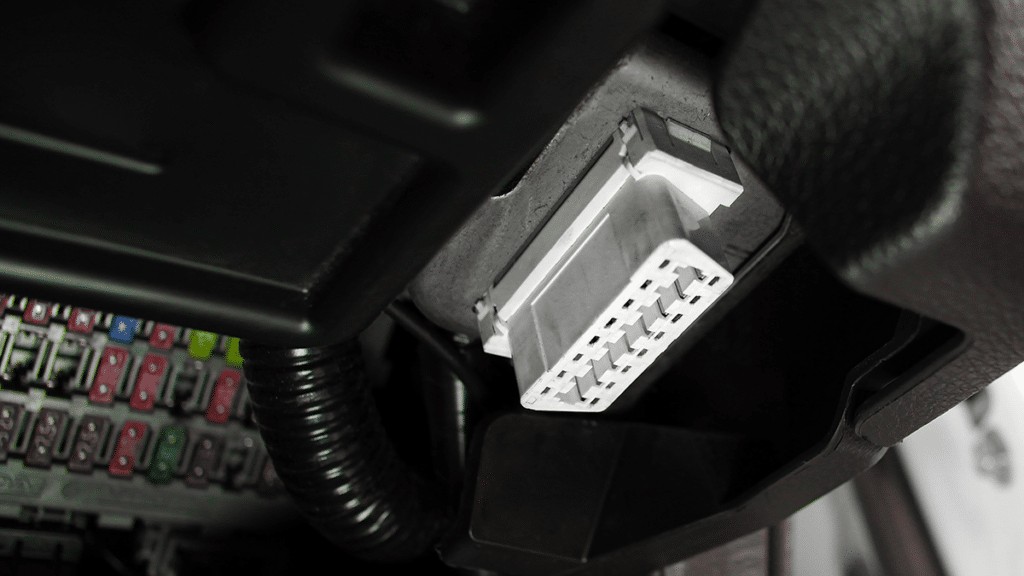For businesses managing vehicle fleets, operational efficiency and peak vehicle performance are paramount. Fortunately, On-Board Diagnostics II (OBD-II) technology, linked with telematics solutions, provides a robust system to achieve these goals. The OBD-II system has become a cornerstone of contemporary fleet management, fundamentally changing how vehicles are monitored and maintained. This sophisticated system transforms standard fleet vehicles into data-rich assets, offering in-depth insights through telematics data, which is critical for optimizing operations and reducing costs.
Let’s delve into the significance of OBD-II in fleet vehicles, exploring its functionalities and the profound impact of telematics data when integrated with fleet management software for enhanced control and efficiency.
Understanding OBD-II: The Vehicle’s Diagnostic System
Think of your vehicle as a complex living entity that constantly monitors its health and operational status. The Engine Control Unit (ECU) is the central processing unit, acting as the vehicle’s brain. It manages numerous critical systems, including fuel injection, ignition timing, and idle speed, to ensure optimal performance. The ECU gathers data from a network of sensors – such as oxygen, coolant temperature, and camshaft position sensors – to dynamically adjust these systems and maintain vehicle performance under varying conditions.
As the ECU monitors these systems, it also tracks vehicle performance and emissions control systems, logging any detected anomalies as Diagnostic Trouble Codes (DTCs). This is where the OBD system becomes invaluable. Data collection and system control are fundamental to the OBD system, which is the universally adopted protocol for accessing vehicle diagnostic information across most light-duty vehicles on the road today.
By connecting diagnostic tools or telematics devices to the OBD port, technicians and fleet managers can retrieve these DTCs to pinpoint issues that might compromise emissions or indicate mechanical problems. This diagnostic capability is akin to a doctor using medical tests to diagnose a patient. Beyond emissions, OBD-II data extends to diagnosing a wide range of mechanical and electrical issues and capturing comprehensive vehicle operational data.
The journey to OBD-II was evolutionary. In the past, vehicle diagnostics relied heavily on mechanics’ experience and intuition. The 1970s, marked by the rise of disco and stricter environmental regulations, saw the introduction of the original OBD system in the United States. Initially, OBD focused primarily on monitoring emissions-related systems to meet new environmental standards.
While the first OBD system was a significant step towards cleaner vehicles, it was limited in scope, monitoring only a few emissions components and a basic level of emissions performance. Technological advancements led to the development of OBD-II, which addressed these limitations. OBD-II established a standardized protocol for communication with vehicle emissions control systems across all vehicle manufacturers. Standardizing the diagnostic connector—the port typically located under the steering wheel—and the data format meant that mechanics could use universal scanning tools across different makes and models. Today, OBD-II’s capabilities extend far beyond emissions, providing a wealth of data concerning almost every aspect of vehicle operation and health, making it indispensable for modern vehicle maintenance and fleet management.
Leveraging OBD-II Data Capture for Fleet Optimization
The OBD-II system has transformed into a comprehensive diagnostic instrument and a vital component for telematics and fleet management solutions. The ECU continuously monitors critical vehicle systems—powertrain, emissions controls, and safety systems—and records any detected faults. By capturing these DTCs, fleet managers can proactively address maintenance needs, preventing minor issues from becoming major, costly repairs. This proactive approach to vehicle maintenance, facilitated by OBD-II data, significantly minimizes vehicle downtime and ensures adherence to emissions compliance standards, crucial for operational efficiency and regulatory adherence.
Telematics devices connected to the OBD-II port unlock access to a broad spectrum of additional vehicle data, including vehicle speed, fuel levels, engine RPMs, odometer readings, and more. This rich data stream enables fleet managers to meticulously monitor and manage not only vehicle health but also driver behavior and vehicle utilization. Analyzing this data provides actionable insights for optimizing fleet performance, reducing operational costs, and improving driver safety.
Specifically, tapping into the ECU via the OBD-II port provides a real-time, detailed view of a vehicle’s internal operations. The data obtained includes:
- Engine Performance Metrics: Comprehensive engine data such as speed, fuel consumption rates, RPM, emissions outputs, intake air temperature, and manifold pressure. This data allows for detailed analysis of engine efficiency and performance under various operating conditions.
- Diagnostic Trouble Codes (DTCs): Standardized error codes that are crucial for vehicle diagnostics. DTCs help identify current problems and, more importantly, predict potential issues before they lead to breakdowns, enabling preventative maintenance and reducing unexpected downtime.
- Vehicle Usage Data: Detailed records of mileage, driving behavior patterns (such as harsh braking or rapid acceleration), and vehicle location. This information is invaluable for optimizing routes, improving driver training, and enhancing overall fleet efficiency.
Telematics: Unlocking Actionable Insights from OBD-II Data
A significant advancement in fleet management, enabled by OBD-II, is the integration of telematics data. Telematics systems act as intermediaries, interpreting the raw data collected by the OBD-II system and converting it into actionable intelligence for fleet managers. This processed data is efficiently transmitted wirelessly, typically via cellular networks, from the vehicle to a centralized, cloud-based fleet management system. Fleet managers can then access and analyze this information through user-friendly dashboards and reports.
Through OBD-II and telematics, fleet managers gain critical insights extending beyond basic vehicle diagnostics. They can monitor engine RPM, odometer readings, precise fuel levels, and engine run-time hours in real-time. This wealth of data provides a comprehensive understanding of vehicle usage and driver behavior, facilitating informed decisions to optimize fleet performance, improve fuel economy, and enhance vehicle lifespan.
Here are key benefits of leveraging telematics data from OBD-II systems for effective fleet management:
Proactive Scheduled Maintenance
By continuously monitoring engine parameters and promptly identifying potential issues through DTCs, fleet managers can schedule maintenance proactively. Addressing minor issues before they escalate into major failures reduces vehicle downtime significantly and minimizes repair costs. Predictive maintenance, driven by OBD-II data, ensures vehicles are always in optimal condition, extending their operational life and maximizing uptime.
Enhanced Fuel Efficiency
Telematics data enables detailed tracking of fuel consumption, idling times, speeding incidents, and harsh acceleration events. By analyzing this data, fleet managers can identify and address fuel-inefficient driving habits. Implementing driver training programs focused on smoother driving and efficient route planning can lead to substantial fuel savings across the fleet, directly impacting the bottom line and reducing environmental impact.
Remote Vehicle Diagnostics
OBD-II integrated fleet management systems facilitate remote diagnostics through DTC code retrieval and analysis. Fleet managers can remotely assess vehicle issues without physical inspections, significantly saving time and enabling quicker problem resolution. Remote diagnostics capability streamlines maintenance workflows, allowing for faster decision-making and reducing diagnostic times.
Streamlined Compliance and Reporting
Telematics data aids in ensuring compliance with various industry regulations, such as hours-of-service compliance for drivers and emissions standards. Furthermore, the data collected is invaluable for generating comprehensive reports, tracking key performance indicators (KPIs), and providing insights into fleet performance trends over time. Accurate reporting and compliance adherence are simplified and automated through OBD-II telematics integration.
The Evolving Future of OBD-II in Fleet Management
The ongoing evolution of OBD-II systems and telematics has paved the way for sophisticated data analytics in fleet management. Advanced data analysis empowers fleet managers to make data-driven decisions, optimizing every facet of their operations from maintenance schedules to route efficiency and driver behavior. To fully capitalize on the potential of OBD-II and telematics data, fleet managers are increasingly turning to advanced fleet management software solutions like IntelliHub. These platforms serve as centralized hubs for monitoring and analyzing fleet-wide data, presenting comprehensive vehicle insights and generating insightful analytical reports that drive strategic improvements.
Traditional vehicle GPS trackers have long utilized OBD-II ports to access vehicle data. However, cutting-edge dash cameras, such as FleetCam Pro, are now integrating both GPS tracking and OBD-II data capture into single, unified devices. This convergence represents a significant leap forward in fleet management technology, offering enhanced capabilities and streamlined solutions.
FleetCam Pro, a leading AI-powered dashcam and video telematics system, harnesses OBD-II technology to deliver a comprehensive fleet management solution. This advanced dashcam seamlessly interfaces with a vehicle’s OBD-II system, capturing extensive data and transforming it into actionable insights via IntelliHub, FTS’s integrated fleet management platform. IntelliHub provides fleet managers with a unified dashboard to monitor their entire fleet in real-time, identify areas for operational enhancement, and make informed decisions that drive efficiency and success.
By embracing the power of integrated OBD-II telematics, fleet managers can achieve unprecedented levels of control and operational efficiency. Leveraging the right tools and data analytics allows for optimized operations, enhanced driver safety protocols, and significant cost reductions, positioning fleets for sustained success in a competitive landscape.


